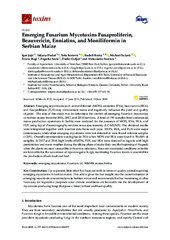Приказ основних података о документу
Emerging Fusarium mycotoxins fusaproliferin, beauvericin, enniatins and moniliformin in Serbian maize
| dc.creator | Jajić, Igor | |
| dc.creator | Dudaš, Tatjana | |
| dc.creator | Krska, Rudolf | |
| dc.creator | Sulyok, Michael | |
| dc.creator | Bagi, Ferenc | |
| dc.creator | Savić, Zagorka | |
| dc.creator | Guljaš, Darko | |
| dc.creator | Stankov, Aleksandra | |
| dc.date.accessioned | 2024-03-13T11:30:18Z | |
| dc.date.available | 2024-03-13T11:30:18Z | |
| dc.date.issued | 2019 | |
| dc.identifier.issn | 2072-6651 | |
| dc.identifier.uri | http://fiver.ifvcns.rs/handle/123456789/4354 | |
| dc.description.abstract | Emerging mycotoxins such as moniliformin (MON), enniatins (ENs), beauvericin (BEA), and fusaproliferin (FUS) may contaminate maize and negatively influence the yield and quality of grain. The aim of this study was to determine the content of emerging Fusarium mycotoxins in Serbian maize from the 2016, 2017, and 2018 harvests. A total of 190 samples from commercial maize production operations in Serbia were analyzed for the presence of MON, ENs, BEA, and FUS using liquid chromatography-tandem mass spectrometry (LC-MS/MS). The obtained results were interpreted together with weather data from each year. MON, BEA, and FUS were major contaminants, while other emerging mycotoxins were not detected or were found in fewer samples (<20%). Overall contamination was highest in 2016 when MON and BEA were found in 50–80% of samples. In 2017 and 2018, high levels of MON, FUS, and BEA were detected in regions with high precipitation and warm weather during the silking phase of maize (July and the beginning of August), when the plants are most susceptible to Fusarium infections. Since environmental conditions in Serbia are favorable for the occurrence of mycotoxigenic fungi, monitoring Fusarium toxins is essential for the production of safe food and feed. | sr |
| dc.language.iso | en | sr |
| dc.publisher | Basel : MDPI | sr |
| dc.relation | info:eu-repo/grantAgreement/EC/H2020/678012/EU// | sr |
| dc.relation | info:eu-repo/grantAgreement/MESTD/Integrated and Interdisciplinary Research (IIR or III)/46005/RS// | sr |
| dc.relation | APV 114-451-2505/2016-01: Application of novel and conventional processes for removal of most common contaminants, mycotoxins and salmonella, in order to produce safe animal feed in the territory of AP Vojvodina, financed by the Provincial Secretariat for Higher Education and Scientific Research, AP Vojvodina | sr |
| dc.rights | openAccess | sr |
| dc.rights.uri | https://creativecommons.org/licenses/by/4.0/ | |
| dc.source | Toxins | sr |
| dc.subject | emerging mycotoxins | sr |
| dc.subject | Fusarium | sr |
| dc.subject | LC-MS/MS | sr |
| dc.subject | maize | sr |
| dc.subject | Serbia | sr |
| dc.subject | mycotoxins | sr |
| dc.subject | Fusaproliferin | sr |
| dc.subject | Beauvericin | sr |
| dc.subject | Enniatins | sr |
| dc.subject | Moniliformin | sr |
| dc.title | Emerging Fusarium mycotoxins fusaproliferin, beauvericin, enniatins and moniliformin in Serbian maize | sr |
| dc.type | article | sr |
| dc.rights.license | BY | sr |
| dc.citation.issue | 6 | |
| dc.citation.spage | 357 | |
| dc.citation.volume | 11 | |
| dc.identifier.doi | 10.3390/toxins11060357 | |
| dc.identifier.fulltext | http://fiver.ifvcns.rs/bitstream/id/11632/bitstream_11632.pdf | |
| dc.type.version | publishedVersion | sr |


